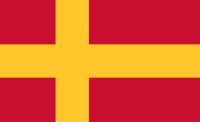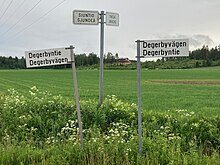Finland Swedish
| Finland Swedish | |
|---|---|
| Fenno-Swedish | |
| finlandssvenska | |
 Unofficial flag of the Swedish-speakers in Finland | |
| Region | Western and southern coast ofFinland,Åland |
| Ethnicity | Finland Swedes |
Indo-European
| |
| Language codes | |
| ISO 639-3 | – |
| Glottolog | east2303 |
| IETF | sv-FI |
Finland SwedishorFenno-Swedish[1](Swedish:finlandssvenska;Finnish:suomenruotsi) is avarietyof theSwedish languageand a closely related group ofSwedish dialectsspoken inFinlandby theSwedish-speaking population,commonly also referred to asFinland Swedes,as theirfirst language.
For the most part, these dialects and the dialects spoken in Sweden aremutually intelligible,although somearchaic dialectsinOstrobothniaare practically unintelligible to Swedish-speaking people in southern Finland (and in Sweden). Most Swedish-speaking Finns emphasize that Finland Swedish is not a separate language from the Swedish of Sweden. The Swedish dialects in Finland are considered varieties of Swedish, and the norm for writtenStandard Swedishis completely applicable also for Finland Swedish. Today, Swedish dialects are spoken in four different regions in Finland: Ostrobothnia,Åland,Southwest FinlandandUusimaa.
Swedish as spoken in Finland is regulated by the Swedish Department of theInstitute for the Languages of Finland.This regulation includes the officially stated aim of keeping Finland Swedish close to the Swedish as spoken in Sweden and strongly phrased advice againstloanwordsandcalquesfromFinnish,which are usually incomprehensible to Swedes.
It is said that the municipality with the highest proportion of Swedish speakers in the world,Larsmo(93% as of 2017[update]), is located in Finland.Korsnäshas also been cited as such. However, as there are no official statistics on the mother tongue of inhabitants of Sweden, this is impossible to verify. In addition bilingualism is very common for immigrants in Sweden, so the termSwedish-speakingmay be deceptive in that sense.
In the spoken vernacular, especially among young people in Finnish-dominated areas, Finnishloanwordsas well ascalquesfrom Finnish are frequently incorporated into Finland Swedish. There are also some words in Finland Swedish that would be considered slightly archaic in Sweden. Some government and public service terms that have been created in recent centuries also differ. The same is true of other new words, notably loanwords fromEnglish.
A common misconception among manySwedesis that Finland Swedish is simply Swedish spoken with aFinnishaccent, something that can be a considerable source of frustration to most native Swedish-speakers in Finland.[weasel words][citation needed]Any language adopts features, especially pronunciation habits, from dominant languages it comes in touch with, but many of the traits of Finland Swedish exist also in monolingual areas and some are in fact preserved features of Old Swedish, as withScotsin comparison withEnglishorAfrikaansin comparison withDutch.
History[edit]

Finland Swedish was a result ofSwedish colonisation of Finlandduring theNorthern Crusadesin the 12th to 14th centuries. Colonisation focused on theFinnish archipelagoand some of its coastal regions. This colonisation led to the beginning of theSwedish-speaking population of Finland.[2][3]
From the 16th century, Swedish was the main language of jurisdiction, administration and higher education inFinland(which was then a part ofSweden), but the majority of the population in the Finnish inland spokeFinnishoutside of these sectors of society, i.e. in normal, daily life. In 1809, when Finland was conquered by theRussian Empireand became an autonomousGrand Duchy,Swedish remained the only official language. In 1863, both Finnish and Swedish becameofficial languageswith equal status, and by the time ofFinland's independencein 1917, after aFinnicizationcampaign by theFennoman movement,Finnish clearly dominated in government and society. See further:Finland's language strife.
Finland has since then been abilingualcountry with a Swedish-speakingminority(5.2% ofmainland Finland's population in December 2019) living mostly in the coastal areas of southern, south-western, and western Finland. During the 20th century, theurbanizationfollowing theIndustrial Revolutionhas led to large majorities of Finnish speakers in all major cities. The capitalHelsinki(in Swedish Helsingfors) became predominantly Finnish-speaking as recently as around 1900. A large and important part of the Swedish-speaking population nevertheless lives in the capital.[citation needed]
The autonomous island province ofÅlandis an exception, being monolingually Swedish-speaking according to international treaties. It is a matter of definition whether theSwedish dialects spoken on Ålandare to be considered a kind of Finland Swedish or not. Most Swedish-speaking Finns and linguists consider them to be closer to some of the dialects spoken in nearby parts of Sweden.
Official status[edit]
Swedish is one of the two official and national languages of the Republic of Finland, the other being Finnish. These two languages have formally equal status in nearly all legislation, though the status of Swedish in Finland has long been a subject of sociopolitical debate.[4][5]The other minority languages (such asSami) are regulated separately.

Finland Swedish is regulated by theInstitute for the Languages of Finland.Official Swedish is not supposed to be very different from Swedish as found in Sweden. There are however e.g. words regarded as archaic in Sweden, but commonly used in Finland, and terms that differ from their counterparts in Sweden, often because of slight differences in the related legislation.[6]
Bilingualism of municipalities is regulated by the Language Act of 2003.[7]If the minority has increased into at least 3,000 persons or 8% of inhabitants, then the municipality must become bilingual. If the minority has fallen below 3,000 persons and 6% of inhabitants, then the municipality becomes monolingual, unless it decides to keep its bilingual status. At present, only one such municipality has done so, namelyLohja(Lojoin Swedish). The status is reviewed once in a decade, and enacted by a government decree issued by theFinnish Council of State.
The country's public broadcaster,Yle,provides two Swedish-language radio stations,Yle VegaandYle X3M.The Swedish-language TV channelYle Femwas merged withYle Teemain 2017 to formYle Teema & Fem.
Phonology[edit]

With the exception of the dialects spoken inOstrobothniaalong the west coast, close to theGulf of Bothnia(example: the dialect spoken inNärpes), Finland Swedish is not particularly different from Central Swedish. The phoneme/ʉː/is more centralized and pronounced like[ʉː],quite similar to how many speakers of English pronounce/uː/(as inmoon). That should be compared to the Central Swedish[ʉ̟ː],which is very close to the short vowel[ʏː]and is morerounded.
The highly variablesjsound/ɧ/varies between[ʂ]and[ɕ~ʃ]on the Finnish mainland, often close toshin Englishshoe.In the Åland Islands, its realization is similar to the velar (and oftenlabialized) pronunciations of nearby parts of Sweden. The historicksound before front vowels and thetjsound, in modern Central Swedish africative/ɕ/,is anaffricate[t͡ɕ]or[t͡ʃ]in all Finland Swedish dialects, close tochin Englishchin,except for some[8]Åland dialects,in which it is a simple fricative [ɕ].[9][10]
Thetonal word accent,which distinguishes some minimal pairs in most dialects of Swedish and Norwegian, is not present in Finland Swedish (except around the parish of Snappertuna, west of Helsinki).[citation needed]Hence, Central Swedishminimal pairslike/ˈandɛn/( "the duck" ) and/ǎndɛn/( "the spirit" ) are both pronounced[ˈandɛn]in Finland.
Finland Swedish lacks theaspirated stopspresent in Central Standard Swedish, making the contrast between"fortis" and "lenis"stops one of voicing only.[11]The retroflexion that occurs in many dialects when/r/precedes a coronal consonant does not occur in certain pairs in Finland Swedish (e.g./rt/,which is realized as[ʈ]in Standard Swedish but[rt]in Finland Swedish).[12]
Vocabulary[edit]
Finland Swedish mostly has the same vocabulary as Swedish in Sweden, and there is a conscious effort to adopt neologisms from Sweden, to maintain cohesion between the two varieties. Nevertheless, there are differences, which generally fall into two categories: words now considered archaic in Sweden, andloanwordsandcalquesfrom Finnish or independently borrowed from other languages (nowadays mostly English). There are also some terms differing because of differing legislation.
See also[edit]
References[edit]
- ^"Professor Catherine O. Ringen".The University of Iowa.May 11, 2011. Archived fromthe originalon 26 October 2014.Retrieved27 October2014.
- ^Haggren, Georg; Halinen, Petri; Lavento, Mika; Raninen, Sami; Wessman, Anna (2015).Muinaisuutemme jäljet.Helsinki: Gaudeamus. pp. 420–421.ISBN9789524953634.
- ^"The Era of Swedish Rule, 1150-1809".History of Finland. Archived fromthe originalon June 22, 2019.RetrievedJune 1,2019.
- ^Hult, F. M.; Pietikäinen, S. (2014). "Shaping discourses of multilingualism through a language ideological debate: The case of Swedish in Finland".Journal of Language and Politics.13:1–20.doi:10.1075/jlp.13.1.01hul.
- ^Kolu, Jaana; Kuronen, Mikko; Palviainen, Åsa, eds. (2016).Svenskan i Finland 16(PDF).Jyväskylä Studies in Humanities. Vol. 298. University of Jyväskylä.ISBN978-951-39-6828-1.
- ^Hällström-Reijonen, Charlotta af; Reuter, Mikael (2008).Finlandssvensk ordbok(in Swedish). Helsingfors: Schildt & Forskningscentralen för de inhemska språken.ISBN978-951-50-1749-9.
- ^Kielilaki 6.6.2003/423 [Language Act of 2003.]
- ^"Äldre man, Brändö: Har ätit sälkött".swedia.ling.gu.se/.Retrieved11 February2014.
- ^"Yngre man, Brändö: Brandlarm på Nordsjön".swedia.ling.gu.se/.Retrieved11 February2014.
- ^"snabbmeny".swedia.ling.gu.se/.Retrieved11 February2014.
- ^Ringen, Catherine; Kari Suomi (2012). "The voicing contrast in Fenno-Swedish stops".Journal of Phonetics.40(3): 419–429.doi:10.1016/j.wocn.2012.02.010.
- ^Kuronen, Mikko (2003)."Finns det supradentala konsonanter även i finlandssvenskan?"(PDF).Svenskans beskrivning 26(in Swedish). Hallgren & Fallgren. pp. 172–177.
This articleneeds additional citations forverification.(December 2006) |
External links[edit]
- SweDia– a collection of dialect samples of Swedish including Finland Swedish
